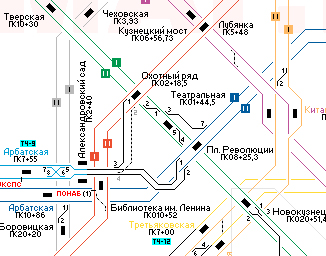The Moscow metro has a wikipedia article that you should consider reading. Although some parts of the text are as strange as my previous post, the article has the general information on the subject. Unfortunately, it doesn’t cover any aspects interesting to an explorer.
Let’s miss out the facts and go a little bit further.
The metro has a number of interlines, which can be easily viewed on the trackmap. All except one [Ploshad revolutsii – Alexandrovsky Sad] are generally not used in rush hours. The forks of the interlines are generally equipped with a bell that goes on is its position changes. But that’s not the most interesting.
Most of the extra tunnel facilities are related to civilian defence.
The metro was used as a bomb shelter at war time. The tunnel design standards include the things the general public will most need. TOILETS (on the left on the photo)!
Two toilets, one male, one female, and no separate one for the handicapped. A short tunnel is built for this purpose – it is the same diameter as the metro, only split in two halves. The bottom has pumps for draining, and the top is, of course, the toilet. The toilet is always a bit higher than the train tunnel level for drainage purposes – in some cases the shit goes by pipe to the nearest pumping station and only then – to the surface.
War isn’t time for privacy!
So, that’s all the commodity you get inside.
The air supply system is another matter. In usual mode, the metro has at least one shaft on every stage between stations, which is equipped with a giant fan that blows the air in or out.
[all information given below, let’s say, is based on the legendary topics on the QWERTY forum, excluding some anal humor and total bullshit]
Another system can be activated in case of emergency.
The metro can approximately be divided in two parts – the deep (in shades of brown on this depths map) and the shallow, marked yellow. The engineers were sure considering the deep part more important in case of direct bombing. The thing marked with the red dot at VDNH station is called the “KPVZ” – which can be translated as “preliminary air intake”. The facility is deep, huge, and unlike the standard shafts, has a fucking lot of fans and air filters. This forced ventilation facility creates extra pressure, which prevents the unfiltered surface air from getting in at any other places. The deep metro parts (brown changes to yellow), are limited by facilities called the VV, translated as “air outlet”, that is supposed to reduce and let out the extra pressure through the shafts. Small local filtering systems exist separately at the shallow parts.
A typical “VV” – air outlet:
All metro tunnels, station exits and small technical galleries have hermetic doors. They serve not only the purposes of air routing, but also can be used to block away parts in case of floods or leakages.
Last, but not least in our list of wartime specialties are the reserve command post bunkers that are not related to the metro’s functioning, but have an exit to the tunnels. Most are still functioning and seriously guarded. Some have even exits to other places.
I added a photo of the GO-42, which was a communication bunker, and was sold due to its total financial disaster, and turned into a damn museum:













